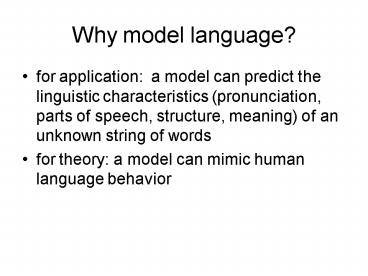Why model language - PowerPoint PPT Presentation
1 / 9
Title: Why model language
1
Why model language?
- for application a model can predict the
linguistic characteristics (pronunciation, parts
of speech, structure, meaning) of an unknown
string of words - for theory a model can mimic human language
behavior
2
Two Current Approaches in NLP
- Symbolic (our approach this semester)
- depends on systems of rules (syntactic,
phonological, semantic, morphological) to analyze
or generate data - used in text understanding, QA, text editing,
etc. - the traditional approach
- Statistical
- depends on statistical analysis of large corpora
- used in speech recognition, information
retrieval, author identification, etc.
3
Example of a statistical model Part of speech
tagging
- Text A The woman ate the cheese before the mouse
- could get across the floor to snatch it. The
mouse - was then throttled by the cat before it could
escape - into the hole in the wall. The poor mouse
thought - the end had come.
- Text B The mouse never imagined that he would
see the _________. - Assuming that Text B is like Text A, What is the
probability that __________ in B is a noun?
4
Example of a statistical model (2)
- Text A The woman ate the cheese before the mouse
- could get across the floor to snatch it. The
mouse - was then throttled by the cat before it could
escape - into the hole in the wall. The poor mouse
thought - the end had come.
- Text B The mouse never imagined that he would
see the _________. - Text A In 9 cases, the is followed by a Noun.
- In 1 case, it is followed by an Adjective.
5
Example of a statistical model (3)
- The probability that _________ in B is a Noun is
.9 - very high the likelihood that it is an
adjective is .1 - very low. - So a statistical part of speech tagger will tag
_____ in Text B as a Noun.
6
Example of a statistical model (4)
- The model is a statistical formula
- P(nounarticle) P(noun ? article)/P(article)
- P 9/10 .9
- (P is probability)
7
Statistical Models
- require training texts (Text A)
- the training sets must be tagged by human judges
TheArt mouseNoun thoughtVerb . . . . - the training set must be large so there will be a
significant number of cases of each part of
speech - usually tested on a test set of data that is like
the training set.
8
Example of a symbolic model
- Rules
- np ? det (adj) n
- A Noun Phrase is a Determiner an
adjective (optionally) a Noun - A dictionary
- word(the,det).
- word(mouse,n).
- word(poor,adj).
9
A Symbolic Model has
- rules
- s ? np vp
- np ? det (adj) n
- vp ? v (np)
- a dictionary that specifies part of speech info
for each word in the language. - word(the,det).
- word(mouse,n).
- word(ran,v).































